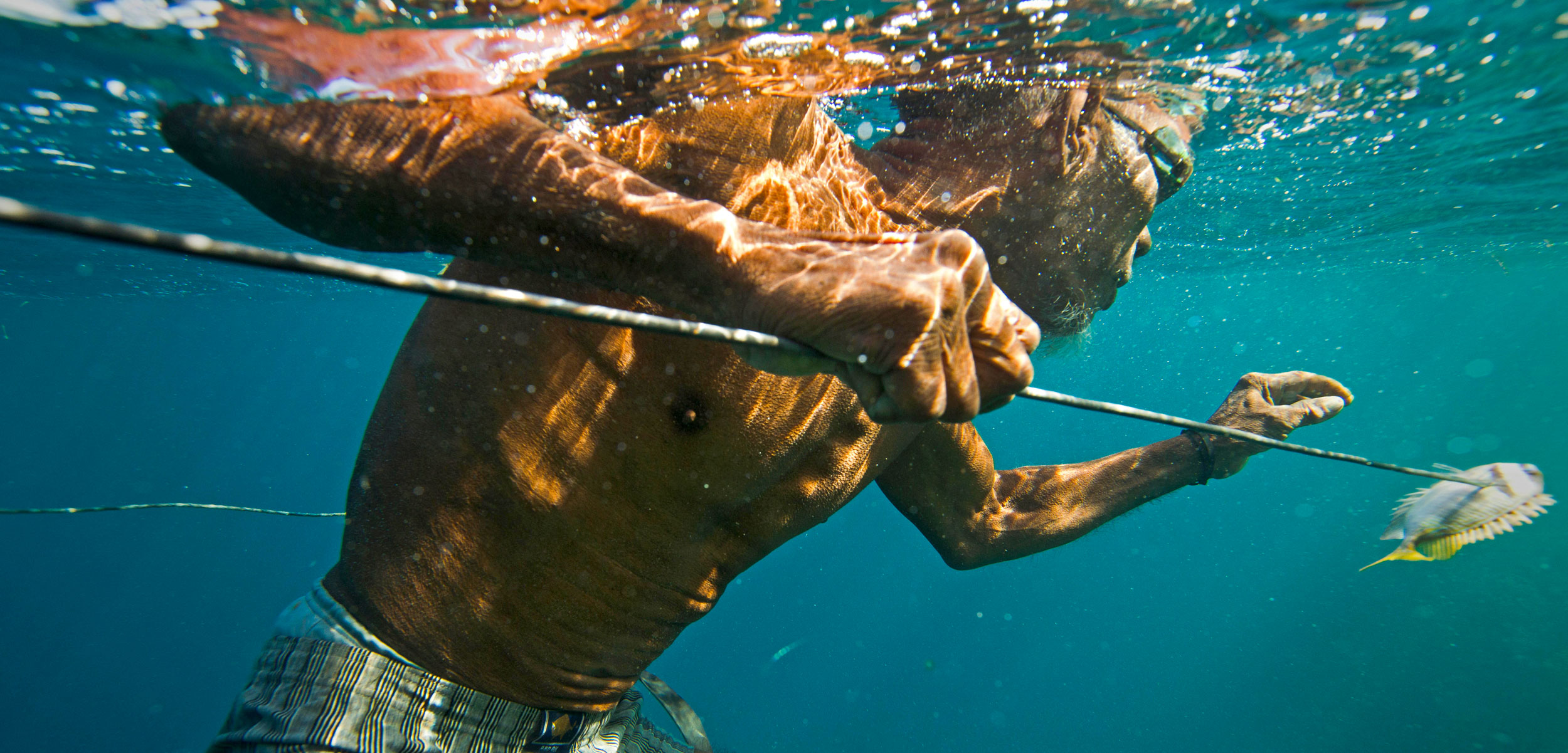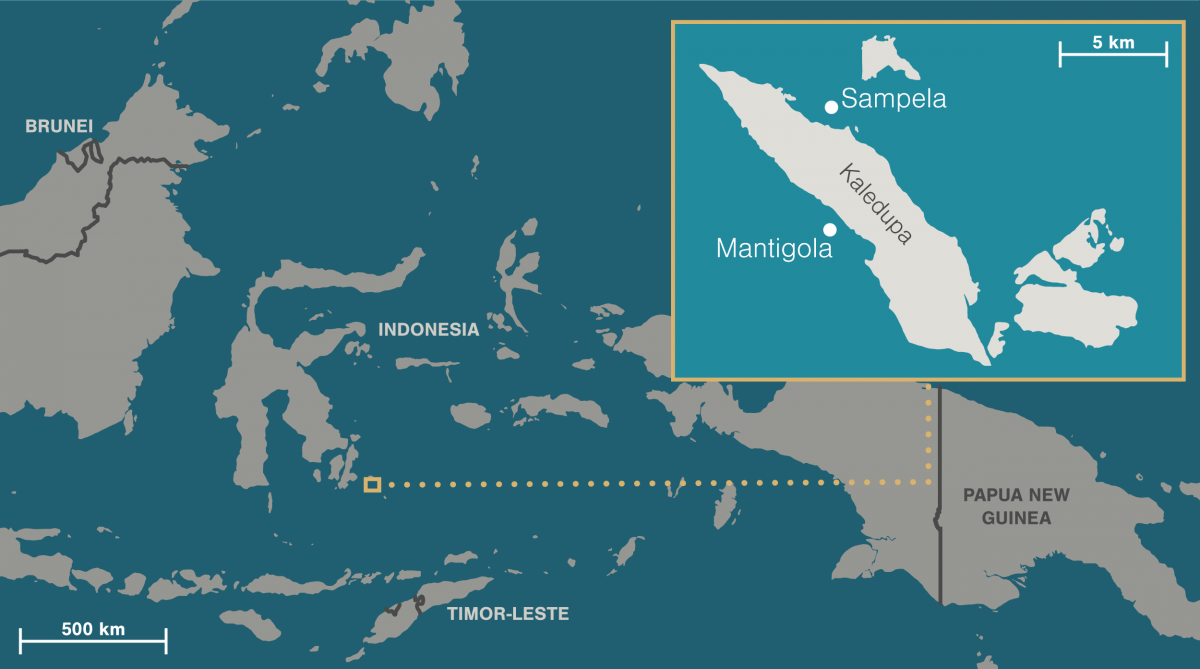Born to Swim
In Southeast Asia, sea nomads known as the Bajau offer a glimpse into how humans may have adapted to an aquatic way of life.
Article body copy
I’m nervous as I jump from the boat into the water. My borrowed flippers are two sizes too big and feel like they’re about to fall off. Holding them in place with my hands seems impossible, as does tagging along on a spearfishing hunt with five men. They’re all Bajau, a people of Indonesia and other Southeast Asian locales known for their almost superhuman swimming and diving abilities.
The best diver in the group, Jaharudin, has a mane of dark hair and the barrel-chested physique of a strongman. He descends easily to the shallow reef below. After about 30 seconds without spotting a fish, he pedals his feet and pops to the surface, snatches a few breaths, and descends again. He chases a school of fish and homes in on a mogo, a bright blue fish that looks illuminated within the translucent sea. Raising his speargun, Jaharudin shoots, striking the moving fish in the eye. He removes the dead mogo from the gun’s spike and swims it up to the boat.
Finally, I find a position that works; the flippers stay in place as long as I refrain from paddling my feet, which is fine. I hover and observe the fishers from a distance—the water is exquisitely clear and they stay close to the boat. Two researchers from Sweden also observe the Bajau—one swims alongside the fishers, the other snorkels nearby—snapping photos and recording video.
For two hours, the fishers perform a ritual far removed from the industrial fishing supply chain. They dive, swim, and hunt—flowing through the water, part of the marine landscape, just more sea creatures slipping through the undulating reef ecosystem. Every fourth dive or so, one of them returns to the surface and lobs a parrotfish, sturgeon, wrasse, or grouper into the boat. As morning turns to noon, the fish pile higher and higher, yet the fishers’ pace never falters, a remarkable feat given their limited recovery time at the surface.
The Bajau are part of the marine landscape, people of the sea, slipping through the undulating reef ecosystem. Video by Sushma Subramanian
Their endurance is impressive. But I had expected a more superlative superhuman feat when I’d asked the researchers, Erika Schagatay, a professor of animal physiology at Mid Sweden University, and Erik Abrahamsson, an anthropologist and photographer, if I could join them on a trip to study the Bajau’s athletic prowess. Jaharudin’s limit is only about 10 meters, at which point the pressure becomes too much for him. In international freediving competitions, by comparison, the winners routinely reach over 200 meters, which is more what I expected of the Bajau.
For Schagatay and Abrahamsson, however, the Bajau are impressive by a criteria different from Western freediving competitions. To the spearfishers, testing how long they can hold their breath or how far underwater they can go without passing out is not important. “They are taking short, repetitive dives and the point is to stay in the water for a long time. This is a completely different strategy from competitive divers,” says Schagatay, when we’re back aboard the boat.
The Bajau—an ethnic group with communities scattered across the Philippines, Malaysia, and Indonesia—strive for efficiency in the water. Their goal is to maximize the amount of food they collect, not what they can accomplish in a single dive. A typical day on the water can span over five hours with Bajau divers submerged for about 60 percent of that time.
What the Bajau demonstrate is something about our evolutionary origins: at some point in our shared history, humans may have physiologically adapted to a more liquid lifestyle, living on the shore and in the waves. Their extraordinary abilities—and even the feats of competitive divers—may actually be rather ordinary.
The fishers tell us the low tide is coming, so we head back to their village, Sampela, in the Wakatobi Islands group in southeastern Indonesia, within the Coral Triangle, a geographical hotspot for coral reefs.
The engine spits smoke the entire ride back, so I cover my face with a towel, leaving my eyes exposed to gaze at the seascape, a hazy scene with no clear line between where the sky ends and the ocean begins. After almost 20 minutes, Sampela’s stilt houses appear in the distance. About 1,200 people live in this ocean community unconnected to land. The closest island, Kaledupa, about 500 meters away, is where the Bajau sell their fish and buy their daily supplies.
Sampela is culturally similar to other Bajau communities, though the language spoken there, Bajo, and certain cultural practices have diverged slightly over the years. Evidence of the Bajau as an ethnic group—known as stateless sea nomads—comes from language analysis. Linguists date the Bajau as a people to 800 CE, though written evidence only traces them back to the 1500s. Many Bajau remain stateless, living on the fringes of society. In Indonesia and the Philippines they are recognized as citizens. Over the last few decades, Indonesian Bajau have embraced a more sedentary life, trading their dugout teak houseboats for houses on stilts, mostly the result of a strong financial relationship with their landed neighbors. A distrust, however, exists between the land and sea dwellers.
According to local historians, the Bajau constructed Sampela in the 1950s after they fled from a similar sea community called Mantigola because of serious tensions with their land neighbors on Kaledupa. Sampela is one of the largest of the new offshore communities they built.
As we approach the village, the sun shining on the blue and orange homes and tin roofs lends a joyful quality to the community. The fishers paddle skillfully between the rustic wood cabanas that are about three meters above the water and connected to each other via salvaged wood walkways. We disembark, climbing a ladder and stepping along rickety planks, skirting people performing familiar chores: sweeping front porches, hanging laundry, and tending children. As the researchers and I head toward the village’s one guest house, I hesitate, aiming for spots where two planks cross, fretting that at any point I’ll fall through the gaps and into the water below. I’m even more worried when a group of children gathers to meet us, the visiting foreigners, wondering if the wood path can take our collective weight.
To reach the guest house we have to cross a single board that stretches like a balance beam to another section of more robust walkway. One of the children notices my hesitation. He grabs my hand and confidently leads me.
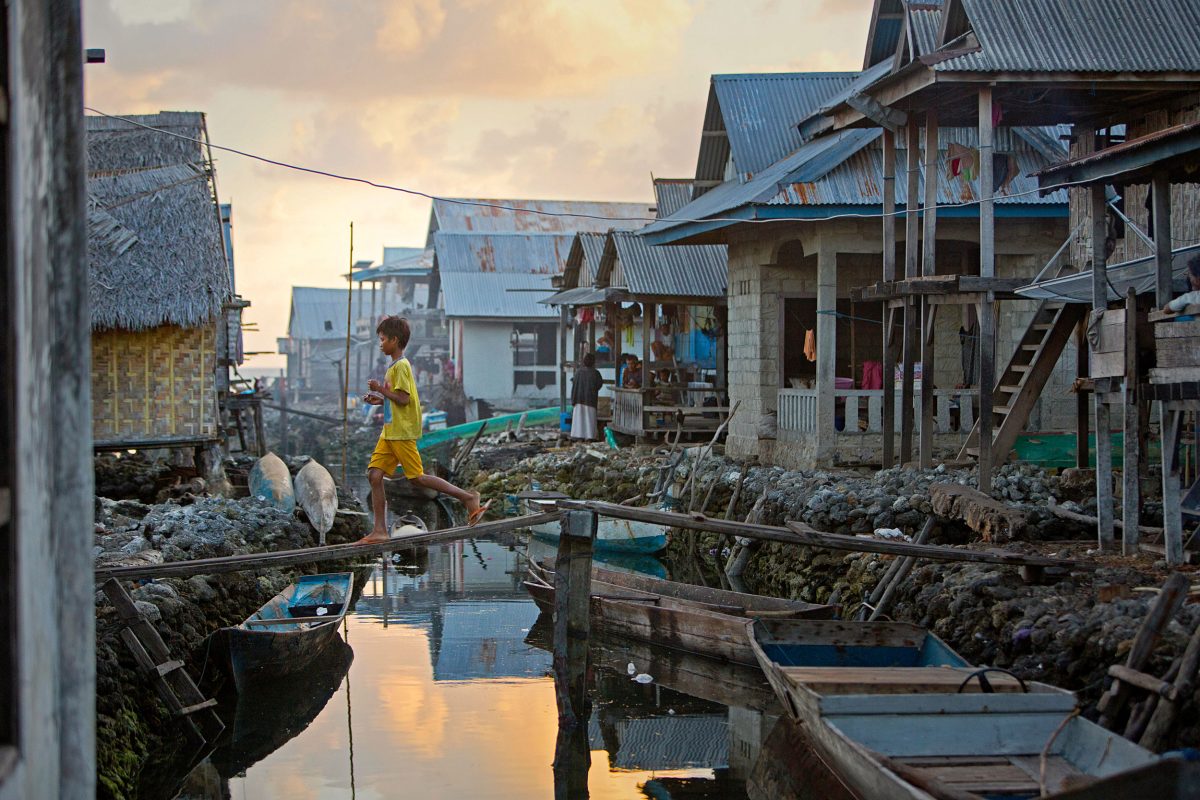
The village may hover over the ocean, but Sampela is like any other community, with shops, a school, and play areas for kids. Photo by Cory Richards/National Geographic Image Collection/Alamy Stock Photo
Once the researchers and I change into dry clothes, we join our host family for lunch, and chat over steaming bowls of vegetable stew, thickly cut homemade potato chips, shellfish swimming in coconut milk and spices, and fried fish and raw fish soaked in lemon juice—each dish simple and comforting. I’m so busy wolfing down my lunch after a tiring morning out at sea that I have to remind myself to pay attention to the conversation.
Schagatay converses in a limited version of Bajo that she intersperses with English, complimenting the meal and asking if she can help serve. Abrahamsson, though close to fluent in Bajo, is much quieter. He’s not as comfortable in group settings and prefers to converse one-on-one. He has his notebook out and jots down any new words he hears.
I ask about the accuracy of reports about Bajau freediving abilities published in travel blogs and news articles: how they puncture their own eardrums so they can dive at great depths without feeling the pressure build up, for example, and how as children they learn to swim even before they walk. Many of these stories, it turns out, are based on hearsay, perhaps because the Bajau communities are so far-flung and have different practices.
Pondang, our host and owner of the guest house, explains that children learn to swim around age three or four—learning any younger than that is considered bad luck. There are no formal lessons. Children observe and experiment on their own. As for deliberately puncturing their eardrums to make diving deep less painful, it’s likely just damage from years of diving. “We don’t do it on purpose,” he says.
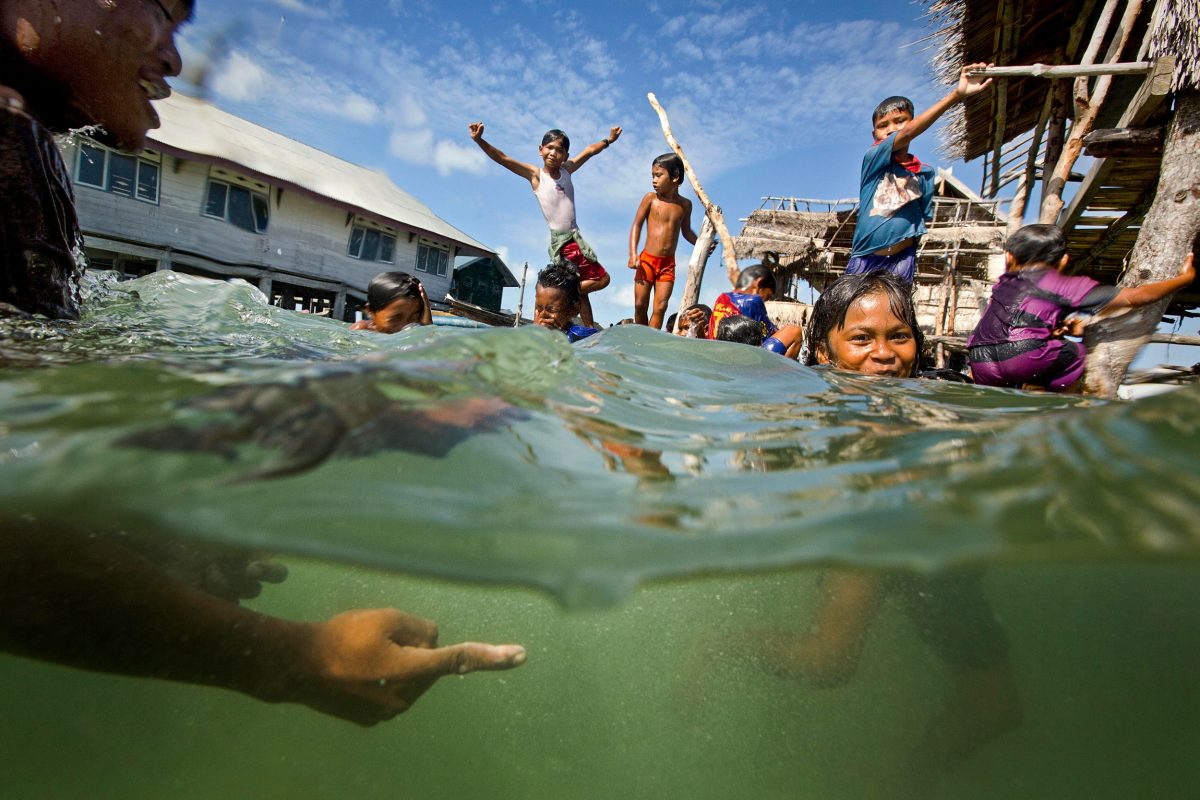
Sampela is a collection of homes built on stilts, the ocean just a splash away. Photo by Cory Richards/National Geographic Image Collection/Alamy Stock Photo
Schagatay’s fascination with Bajau physiology began in 1988 when she was studying the physical traits that make humans good divers. She wondered if our innate physical comfort in the water conveys an advantage in some environments. She came across mentions of “sea gypsies” in travel writing by Dutch colonialists from the late 1800s and a map indicating that one of the groups lived in the region of Sulawesi in central Indonesia. With an interpreter and a friend, she went in search of the community.
Schagatay arrived in the village of Topa by boat and met the Bajau chief, who told her she was the first Westerner to visit them. They built rapport as they swapped stories of their cultures—the chief explained the Bajau’s ease in the ocean, and she told him about Swedish ice fishing. The chief introduced Schagatay to community members, some of whom agreed to take part in her research.
Her thesis, defended in 1996, included research into the Bajau’s diving abilities and built on prior work on the human dive reflex, a phenomenon first discovered in the 1960s by Swedish physiologist Per Scholander. Scholander determined that when people submerge themselves in cold water, their heart rate slows dramatically and they require less oxygen. The capillaries in their extremities close off, first in the fingers and toes, then the hands and feet, slowly working inward to shunt blood to the heart and brain. With a limited oxygen supply, the body generates energy anaerobically, causing lactic acid to build up in muscles until oxygen flow is restored. Scholander noted how similar this response was to the dive reflex of aquatic animals, such as porpoises, seals, and beavers.
Immersing your face in cold water is enough to activate the dive reflex: Schagatay identified and located specific thermoreceptors that trigger the response. She also found that the dive reflex strengthens with training, a practice the Bajau undertook almost daily by simply going fishing. A stronger dive reflex delays the moment when a diver needs to take another breath.
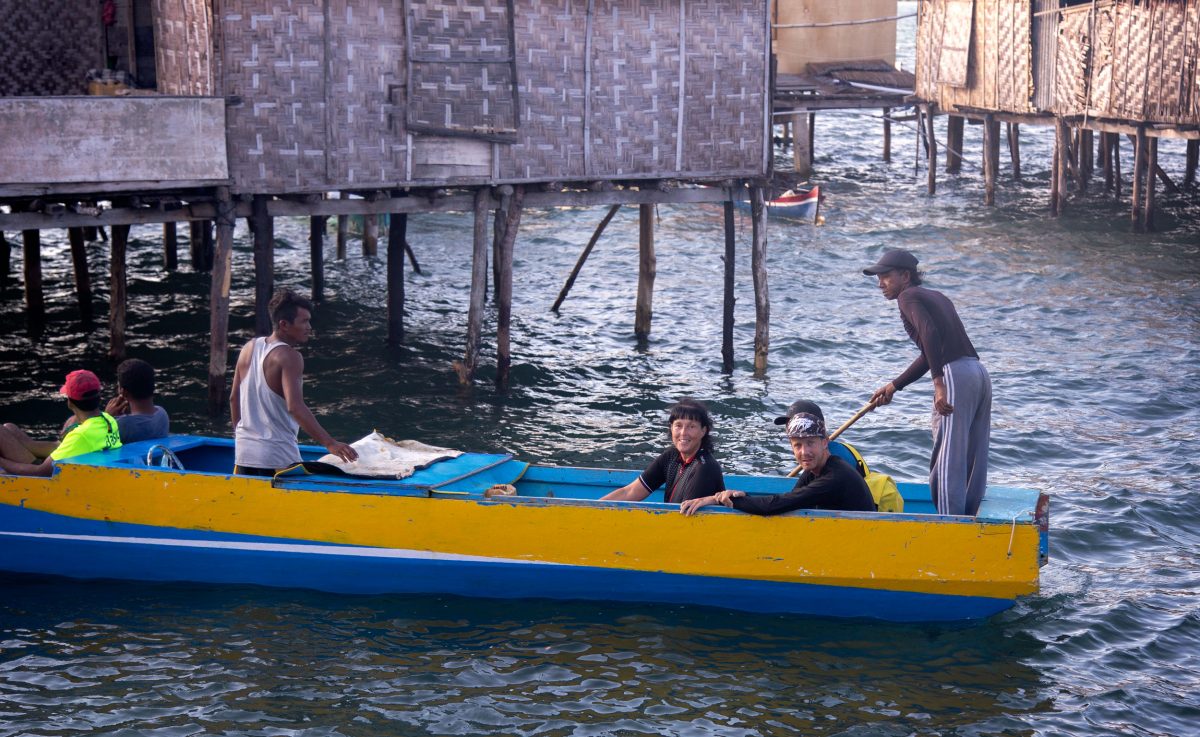
Researchers Erika Schagatay and Erik Abrahamsson, sitting in a Bajau boat, have collaborated on their Bajau studies since 2014. Photo by Sushma Subramanian
Schagatay had always meant to return to study the Bajau’s abilities, but the opportunity eluded her for years. In 2007, Abrahamsson read Schagatay’s thesis and contacted her right away. They met at Mid Sweden University while he was working on his undergraduate thesis: he too wanted to study the Bajau, but with a focus on their coastal lifestyle and culture. Three years later, Abrahamsson traveled to the Philippines to study a Bajau community for the first time, gathering data and later sharing it with Schagatay. On his second trip, he went to Topa, where he met the same village chief. It was the beginning of his immersion in Bajau communities throughout Southeast Asia. Over the years, he’s improved his swimming and diving skills, absorbed the nuances of the culture, and picked up numerous Bajo dialects, and he and Schagatay began collaborating, together visiting Sampela and other Bajau communities.
Despite Abrahamsson’s fluency, however, communication is still challenging for scientists looking for a mechanical explanation for how the Bajau do what they do. Jaharudin joins us at our lunch table and Schagatay asks him, through Abrahamsson, how he knows when it’s time for him to surface during a dive. He says he has no real strategy. He can stay down for quite a while if he’s targeting a fish.
Schagatay grabs the area around her diaphragm and exaggerates the feeling of a contraction. “Do you feel this?” she asks.
Jaharudin nods, but it’s unclear if her actions translate accurately. Her question is crucial to understanding the physiology behind their diving, since their timing is what allows them to stay in the water for hours, spending an average of 28 seconds underwater and 19 seconds at the surface recovering. Determining the bodily signals divers rely on is tough, and it’s why the researchers dive with the Bajau and observe them in the water. They may identify clues that escape them in discussions.
At the end of our enormous lunch, Pondang’s seven-year-old son arrives, in search of leftover potato chips. He happily grabs a large handful and runs away, our cue to get up as well.
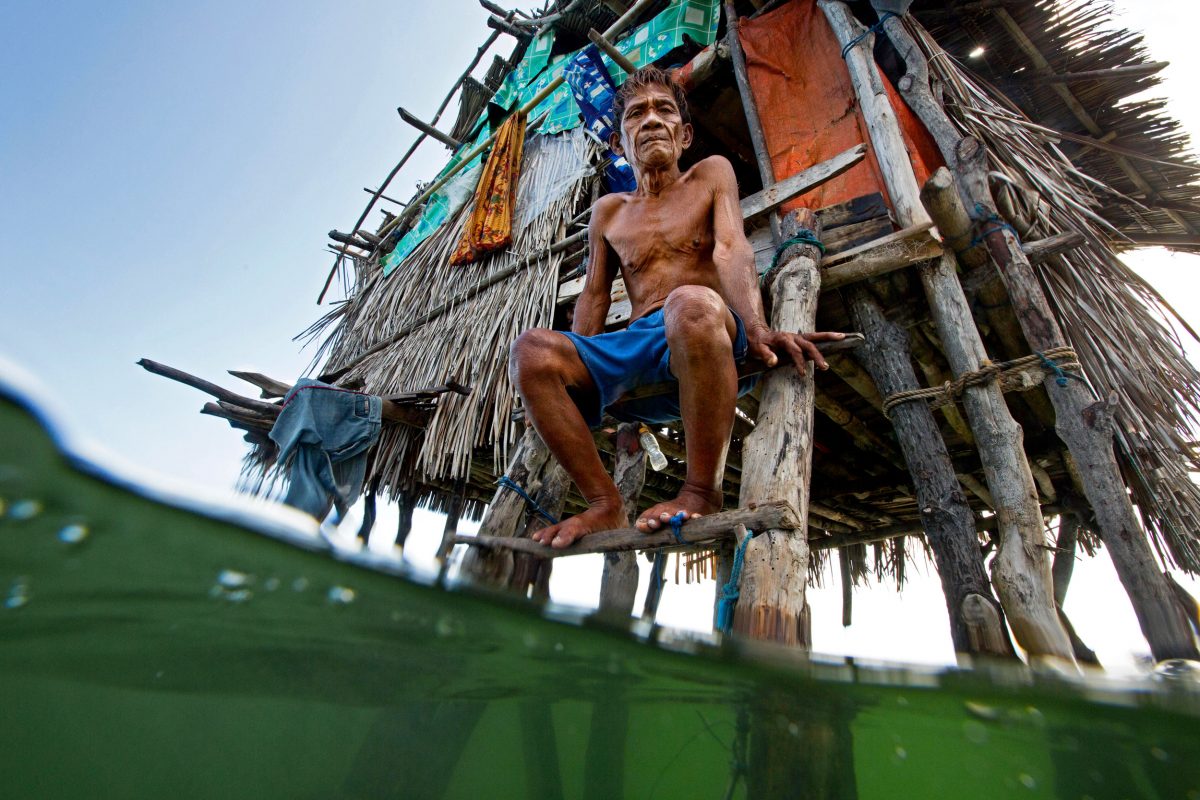
Homes are constructed of wood, woven rattan, and tin for roofing. The water beneath the homes ranges from knee-deep to a couple of meters, depending on the tides and time of year. Photo by Cory Richards/National Geographic Image Collection/Alamy Stock Photo
I have a room to myself in the two-room guest house I share with Schagatay. In her room, the ocean peeks through bamboo wood floors. My body is damp and sticky from the oppressive heat and the salt water, though the breeze coming in through the curtains of the small window helps. A tankful of clean water in the guest bathroom is tempting, but it’s a luxury—a boat from Kaledupa delivers water in limited supplies to Sampela. I opt for baby wipes and lie down on a queen-sized mattress on the floor, underneath a mosquito net.
I’m full and clean and sleepy, and that’s probably why the rocking of the house beneath me now feels less like a constant threat and more a comforting embrace from the ocean.
Sampela sways with the ocean but as a community it is like any other, with a school, a small soccer ground built on stacks of white corals, and shops selling flip-flops and T-shirts. When they’re not working, neighbors get together and chat and play card games. Apart from living on and making their living from the ocean, their lives are ordinary. To Schagatay, their swimming too might be more commonplace than we think.
Schagatay has spent most of her career studying the physiology of athletes and other amateur sport divers who routinely test their limits, as well as recreational divers and other subsistence food divers, such as the Ama of Japan. Starting in 2009, she published a series of scientific papers summarizing the bodily adaptations and strategies used to extend dive times in three major competition disciplines—static breath-hold (divers holding their breaths as long as possible underwater without moving); breath-hold while swimming (the maximal horizontal distance underwater); and freediving to the maximal depth. The longest static breath-hold is about 24 minutes. The record for breath-hold while swimming is 177 meters in three minutes and five seconds. And the world record champion for no-limit freediving reached a depth of 253 meters and held his breath for more than nine minutes.
The village of Sampela in Indonesia. Video by Muan Sibero/Shutterstock
To attain these world records, competition freedivers learn specific techniques to extend dives by increasing oxygen stores, decreasing their oxygen consumption, and tolerating lower levels of oxygen in the brain. They also learn a process called lung packing: divers use their tongues as a pump to press down small volumes of extra air while above water, adding three liters of air beyond what the lungs typically hold. But many competitive freedivers also have physiological adaptations—a spleen up to twice the average size, or, sometimes they have an extra functional spleen. When oxygen levels in the bloodstream are low, the spleen releases red blood cells, which store oxygen. A larger spleen in competitive freedivers can increase dive times by as much as 30 seconds. But is having a large or additional spleen an extreme individual adaptation or a human evolutionary adaptation to a watery environment?
Rather than viewing this diving ability as an extreme feat, Schagatay sees it as a basic human capacity that we could all unlock if only we explored it for ourselves, within the safety of an organized dive club. In her research, Schagatay noticed that people who train safely often discover that freediving is easy. “It is amazing just how fast some people, without any previous experience, learn the art of deep and long distance diving or breath-holding for several minutes,” she wrote in a 2014 paper. The Bajau divers may be operating closer to the threshold of what the human body can do than the average person.
At our guest house, Schagatay and Abrahamsson set up a makeshift lab and methodically test research volunteers, trying to tease apart the ultimate question: are the Bajau exceptional because of practice or genetic predisposition? The researchers won’t give away details—their conclusions will be published later in a scientific journal—but there are indications of both.
The Bajau’s spleens caused quite a buzz a few months before Schagatay and Abrahamsson’s latest visit to Sampela. Melissa Ilardo, who is now a postdoctoral scholar at the University of Utah in Salt Lake City, published a study in the journal Cell showing that the Bajau of Jaya Bakti near the Indonesian island of Sulawesi had larger spleens than people in a neighboring village on the mainland. Even the Bajau who didn’t dive regularly had bigger spleens, on average, than members of the nearby farming community.
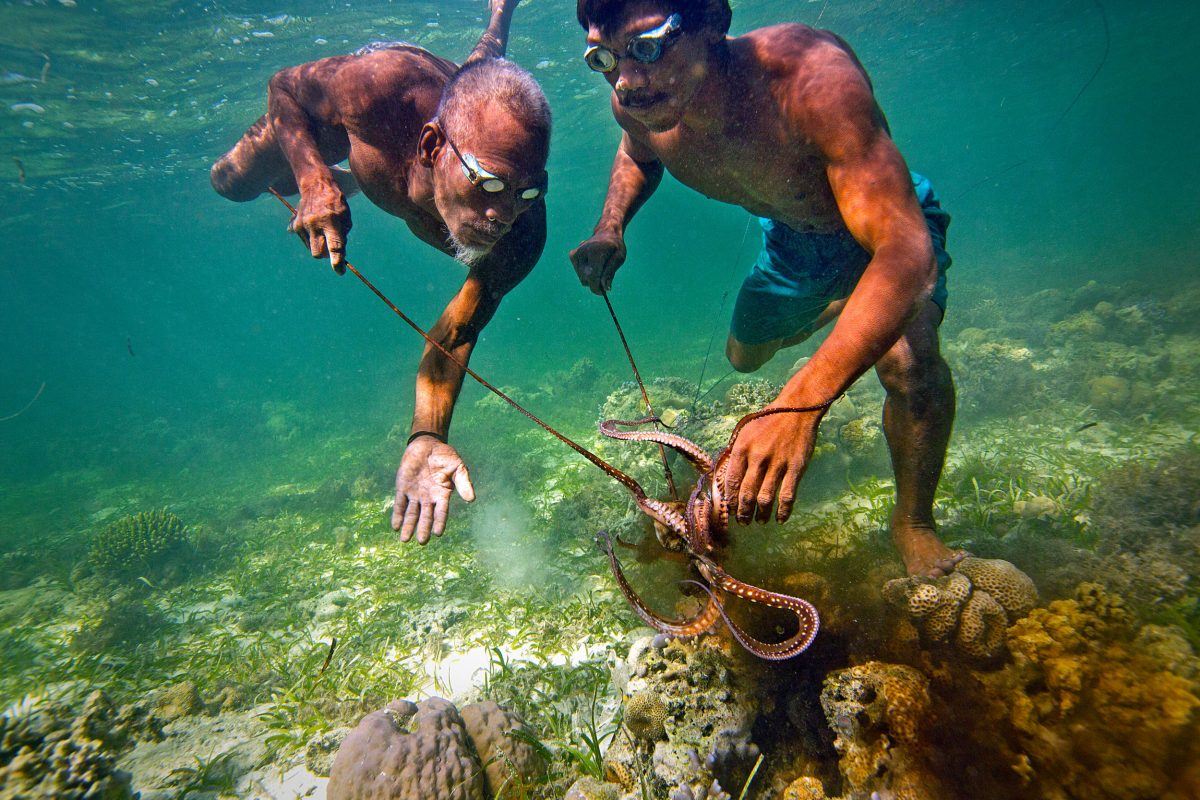
Bajau divers spend 60 percent of their time underwater while out fishing. Photo by Cory Richards/National Geographic Image Collection/Alamy Stock Photo
A DNA analysis found that the Bajau had a higher frequency of a specific gene, PDE10A, shown to make spleens grow in mice. The Bajau were also more likely to carry certain genes connected with an enhanced dive reflex and for preventing the build-up of carbon dioxide in the blood. According to the paper, the Bajau and their land-dwelling neighbors probably diverged 15,000 years ago, offering plenty of time for the development of specific adaptations for their oceanic lifestyle. Press accounts heralded the paper as evidence of recent human evolution.
“I have seen many similar physiological adaptations in freedivers from all over the world, and these other people may have similar genes,” Schagatay says. Another explanation for the paper’s findings could be that the genes coding for spleen size and certain dive reflex functions existed in early humans but as we lived mostly on land, those genes were silenced. They may have re-emerged in the Bajau because of certain lifestyle triggers. Even if finding these genes in ancient DNA proves elusive, humans have larger spleens than many related species, such as chimpanzees and gorillas, possibly an adaptation to a coastal lifestyle long ago.
Schagatay’s initial findings in the Sampela Bajau reveal they too have larger-than-average spleens and those with the largest spleens are also better divers. She is in the process of figuring out why, since the Bajau don’t spend so much time underwater during a dive that their blood-oxygen levels would necessarily trigger the spleen to release red blood cells. She has one theory, which she confirmed while watching some of the better divers, such as Jaharudin. He seems to exhale air from his lungs to reduce his buoyancy and descend faster. Without air in his lungs, the oxygen stored in the spleen may be essential.
Overall, physiological traits like those found in Jaharudin, and in competitive freedivers around the world, is a compelling clue that our comfort in the water was evolutionarily useful at some point in our history.
And yet, the idea that humans have evolved to be good swimmers and divers is a controversial one because it tends to get associated with the much-ridiculed aquatic ape hypothesis, which was first posited by Alister Hardy at Oxford University in the 1960s.
A marine biologist, Hardy had been interested in the question of why humans have a layer of body fat under our skin, unlike other primates, and thought that it was somewhat analogous to the blubber of marine mammals. He never believed that humans were fully aquatic like whales or dolphins; rather, he argued that we foraged for aquatic foods, which kept us in the water for hours. He pointed out a number of other human traits that seemed to equip us for a coastal life, such as our hairless bodies and an upright posture, which he thought may have arisen from wading on our two legs to keep our heads out of the water.
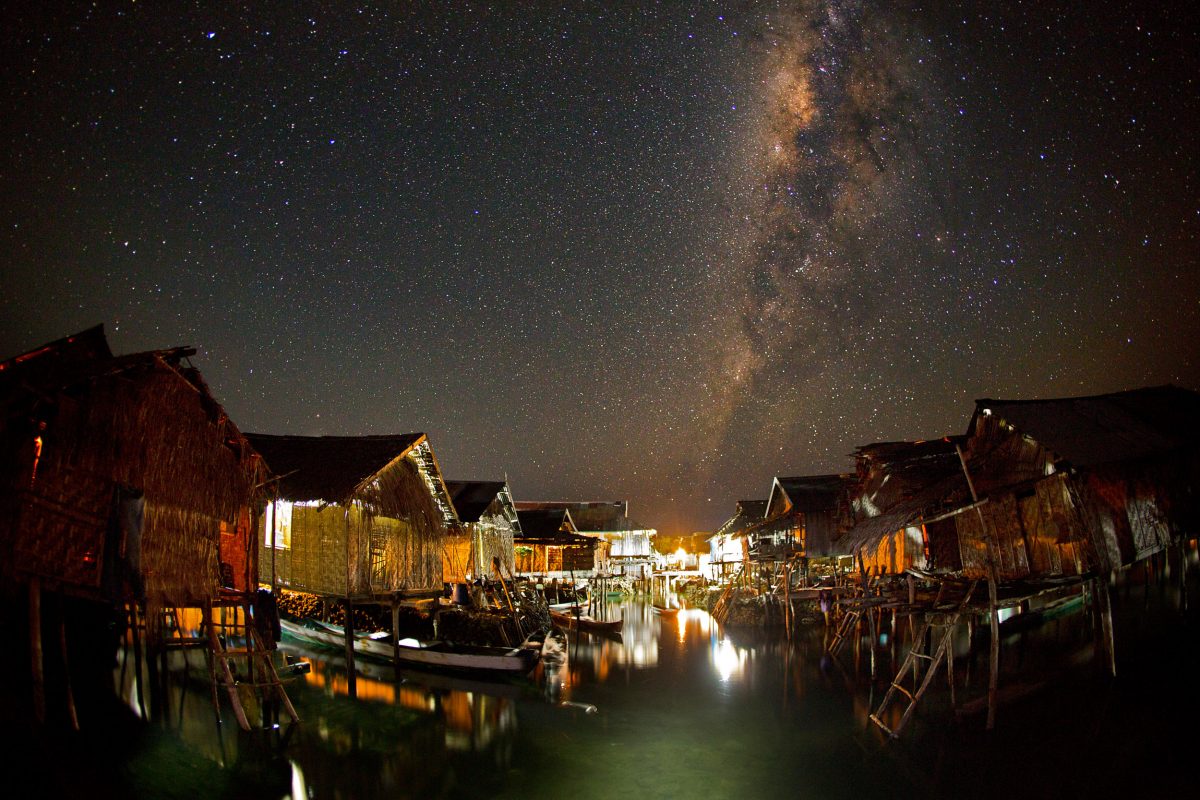
On a clear night, it’s easy to see the Milky Way stretching above Sampela. Photo by Cory Richards/National Geographic Image Collection/Alamy Stock Photo
Hardy came up with his idea at a time when many anthropologists were trying to explain how humans split from the great apes, and he was chided by his marine biology peers for crossing over into anthropologists’ territory and promoting a theory that was antithetical to the dominant one at the time: that we had evolved on land, learned to walk on two legs across the dry savannah, and used tools to become great hunters. Hardy tabled his idea. But then popular science writer Elaine Morgan picked up the theory and promoted it in her book The Descent of Woman, a bestseller in 1972.
Even more lay people advocated the theory, and the media soon honed in on stories about ancient humans who were as aquatic as mermaids. But what’s lost in the chatter about some mythological bathing ape is the much more modest and prosaic idea that at some point early humans began swimming and diving to harvest food from the sea and, in the process, attained certain skills. Our evolutionary story has changed dramatically since Hardy’s time. No longer do scientists think of the dry open savannah as the laboratory that gave rise to humans. Now, most agree that our species arose in a “savanna mosaic” that was a mixed environment of forest, open plains, and water that would require a variety of abilities to thrive.
There is also evidence that people were eating shellfish as far back as 165,000 years ago in South Africa, within the window that anatomically modern humans emerged. When resources were scarce on land, humans likely relied on a relatively stable supply from coastal waters. The Bajau provide a model for how humans could have thrived on the seascape. In recent years, modern tribes such as the terrestrial San people of southern Africa who chase down their prey on foot, have helped to support the born to run theory. Similarly, the Bajau show us that we may also be born to swim. Humans are, after all, animals that rely on various strategies, depending on the environment, to find food.
In 2014, Schagatay and Andreas Fahlman, at the Oceanogràfic Foundation in Valencia, Spain, who studies the physiology of animals in challenging environments, looked at how human diving compares with the diving of semi-aquatic mammals that spend their time both on land and in the water. They found that human abilities are somewhat in line with the so-called shallow divers: otters, beavers, hippos, and sea cows, which also have a capacity for training their lungs to increase storage capacity.
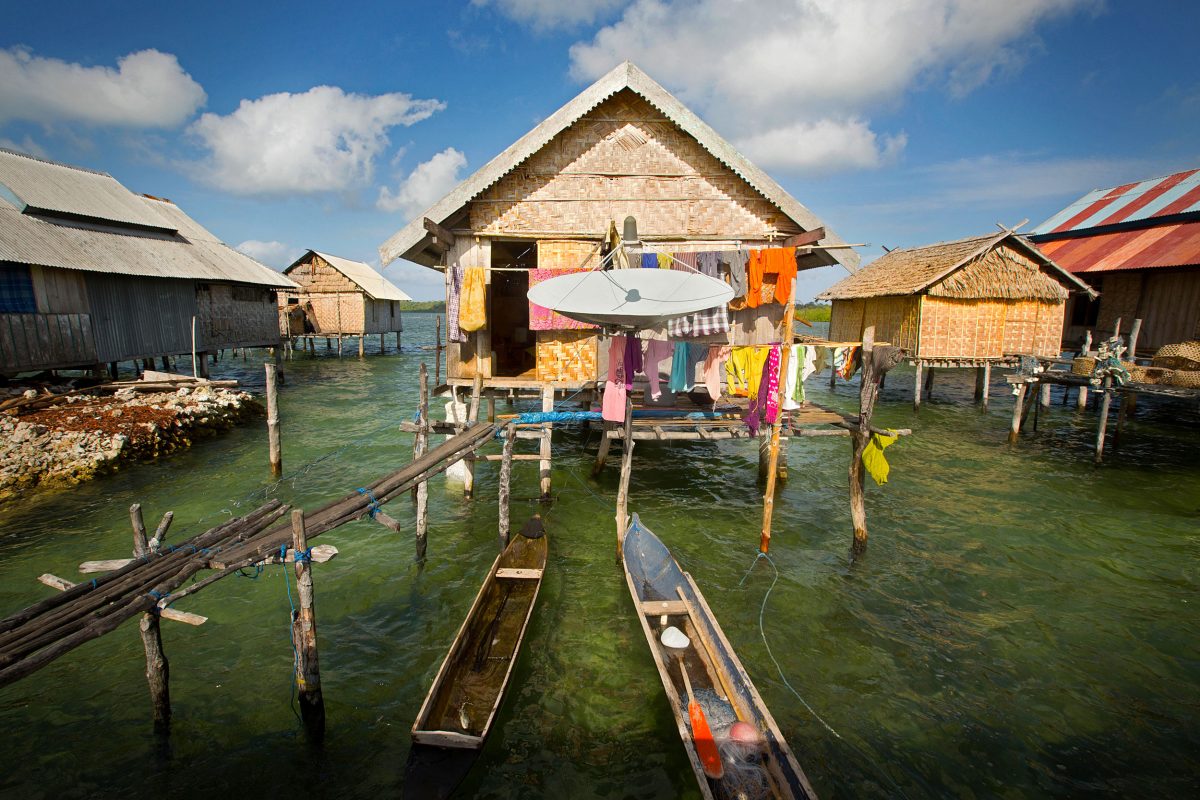
Houses in Sampela are connected by wooden walkways. Photo by Cory Richards/National Geographic Image Collection/Alamy Stock Photo
Shallow divers tend to stay at depths of less than 50 meters but can reach maximum depths of slightly more than 100 meters. They typically stay underwater for between two and 10 minutes, similar to the maximum capacity of humans. Of course, there is no perfect comparison between shallow-diving animals and humans since it’s unclear if shallow-diving mammals are at full capacity when we measure them. But just like humans, they make either several short dives with small rests in between, or a single deep dive, after which they’re observed to need a rest. Schagatay compares the Bajau diving method to that of a sea otter, plunging repeatedly to the seafloor to pick up sea urchins.
If we’re looking at the Bajau in evolutionary terms, Schagatay believes the foraging done by women is probably most indicative of how a way of life built around the coast got its start. During low tide, they forage for sea urchins, sea cucumbers, and shells, mostly in water two or three meters deep, similar to those early humans in South Africa. The longest they hold their breath is about 20 seconds. The Bajau have told Schagatay that when they were living on boats, the women did a lot of the breath-hold diving as well. It was the move to houses and the need to take care of a more complicated domestic life that led to separate gender roles.
In the afternoon, when the weather cools ever so slightly, we ride out on a boat with a group of women equipped with handmade wood goggles. At a spot where the water is about waist-deep we drop anchor. The group hops out and scours the ocean floor for prey, one woman towing a container for the catch, their task aided by yet another unique adaptation: underwater vision. When most of us are underwater, our pupils open up like the aperture of a camera to adjust to an environment with less light. But studies on other Austronesian people similar to the Bajau show that for them the opposite happens. Their pupils shrink, sacrificing some of the light for a sharper image.
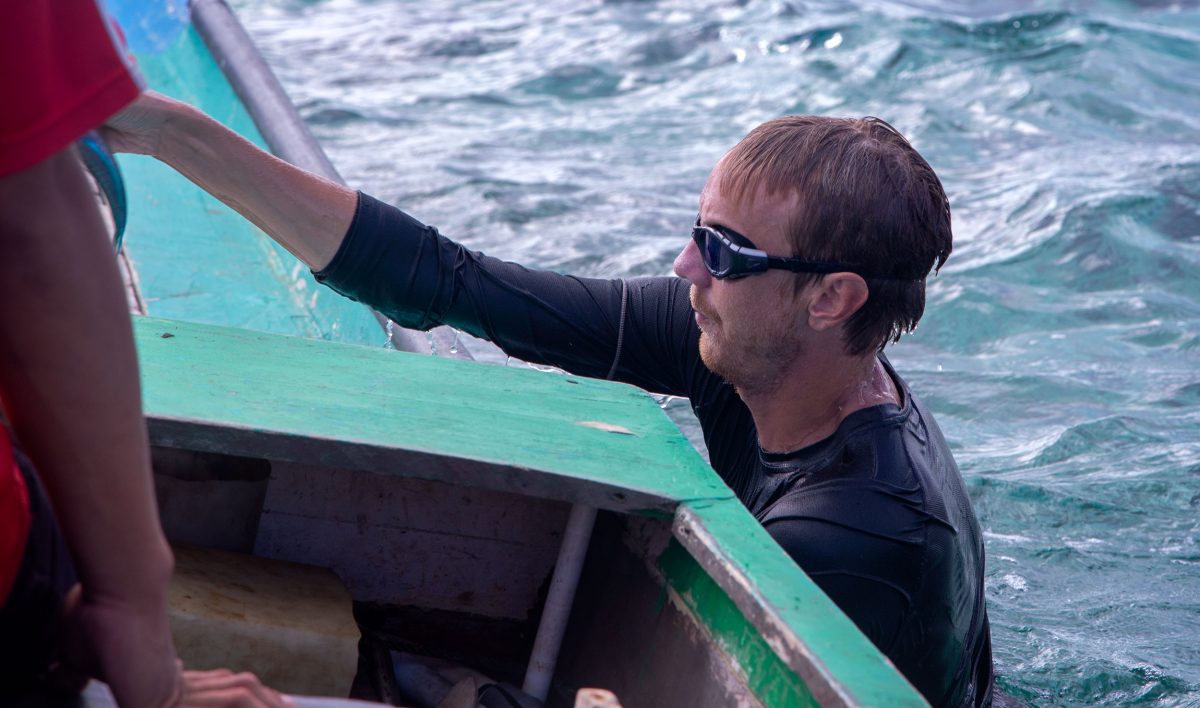
Erik Abrahamsson is a Swedish anthropologist and photographer researching the coastal lifestyle of the Bajau in Southeast Asia. Photo by Sushma Subramanian
I follow the women, looking down, trying to see what they see. I never do. I float on my stomach, lost in thought: I’d always imagined ancient humans grounded firmly on land, but watching the Bajau women working underwater, I see a different human story, one in which the sea offered a welcome respite from the heat and it didn’t take any extreme hunting skills to survive off its easy pickings. A pair of long legs materializes in front of me, interrupting my musings, and I sink my feet to the seafloor.
“Ooooouch!” I cry out.
The legs belong to Abrahamsson, who stops and asks if I’m alright. I play it cool. But the pain is some of the worst I’ve ever felt in my life—as if a knife has sliced open the bottom of my foot. I check for blood but see none. The water is shallow enough that I could walk on the seafloor, but I swim to avoid putting pressure on my foot, thrashing my arms and legs vigorously to distract myself. Finally, after a long time quietly fretting and treading water, I hear one of the women say she’s cold. The container is full and everyone agrees it’s time to go. I’m the first to jump back on our small boat, and I quickly go to the back and check what’s wrong. It looks as if an animal has clawed my foot. I wave down one of the women, Naya, and show her.
She looks at me sadly. “Sakit,” she says.
It sounds like “suck it.” I’m not sure if she’s telling me to put my foot to my mouth to extract whatever’s inside. I consider it for a moment, but I’m not that flexible. I sit patiently until we’re back at the village with the translator.
Back at Pondang’s guest house I find out I stepped on a sea urchin. The spines are deep in my foot. “Sakit,” the translator repeats when I ask what it means. “There must be a lot of pain,” she explains, looking worried. She goes in search of a lemon so I can squeeze the juice over my pierced skin to keep it from getting infected. She also brings a safety pin, but there’s no way to tease out the slender needles embedded in my flesh. All the children have heard what’s happened, and they surround me, staring at my foot. I’m embarrassed.
Schagatay and Abrahamsson put away their equipment and briefly go over their findings. Pondang intercepts Schagatay to show her the progress on a new house she’s commissioned him to build for her subsequent visits. Both scientists plan to keep coming back to Sampela and to the other Bajau communities they study to continue collecting data, hoping to learn more about the human capacity for swimming and diving.
As I nurse my throbbing foot, I realize that somewhere within my body may reside great swimmer and diver genes, but I’ve learned that community and environment shape these innate reflexes and the marvelousness of it all is a testament to human adaptation.
Reporting for this article was funded by a Genetics and Behavior Journalism Fellowship. Special thanks to Rena Pasandre for facilitating the author’s interviews in Indonesia.

